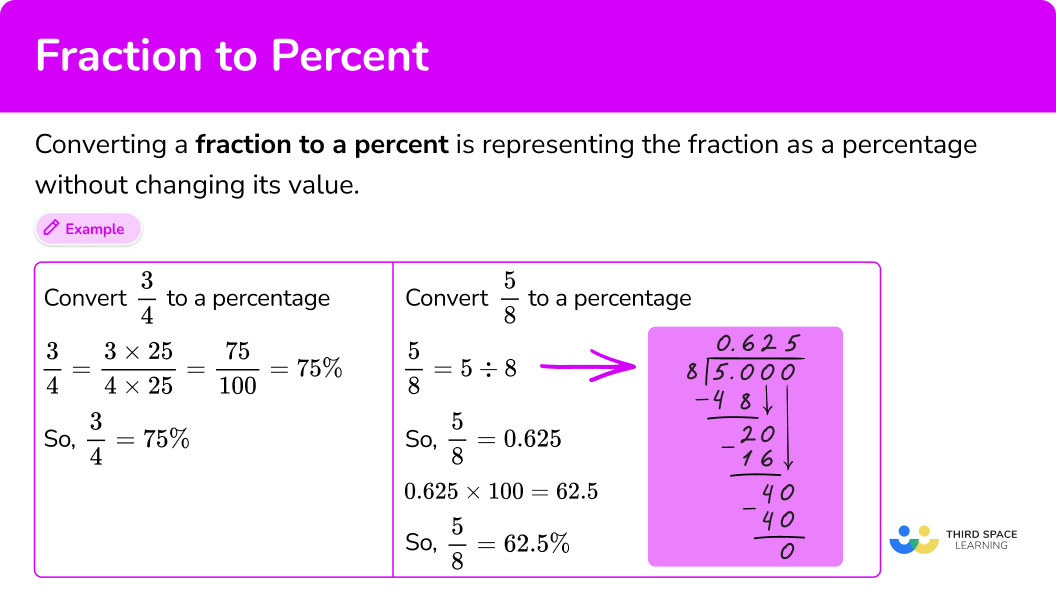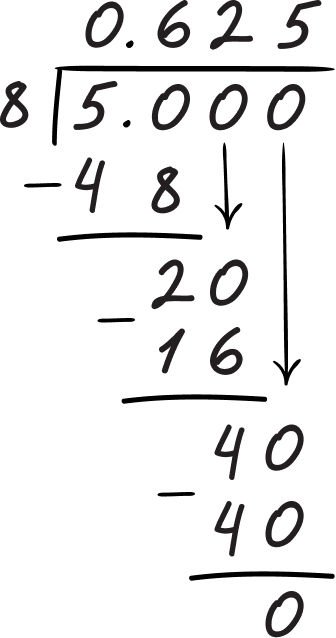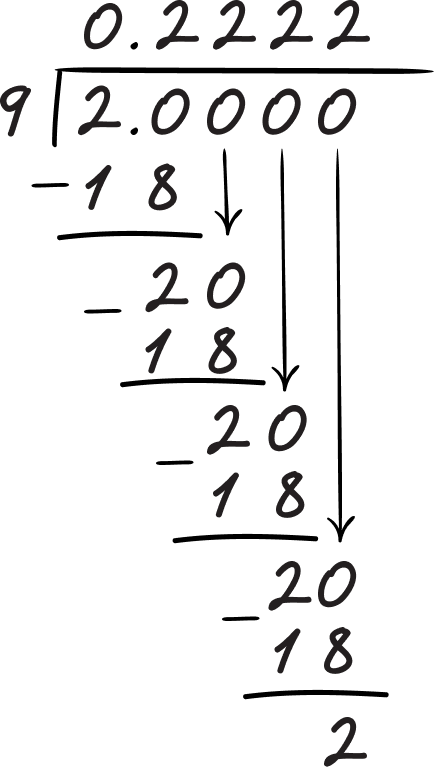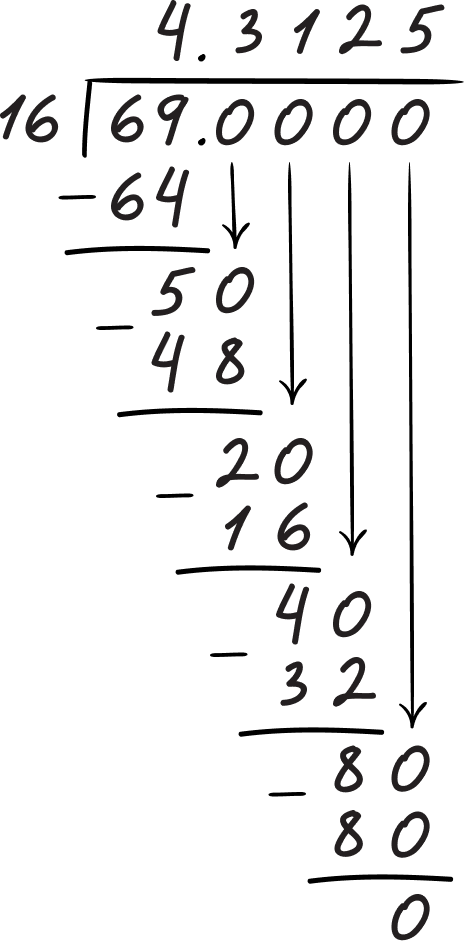High Impact Tutoring Built By Math Experts
Personalized standards-aligned one-on-one math tutoring for schools and districts
In order to access this I need to be confident with:
Percent Percent of a number Multiplication and division Simplifying fractions Mixed number to improper fraction Equivalent fractionsFraction to percent
Here you will learn about converting fractions to percentages.
Students will first learn about converting fractions to percentages in 6th grade math as part of their work with ratios and proportional relationships and will expand that knowledge to solving problems finding the whole given a part and the percent, or finding a part given the whole and the percent.
This will later be used to find the percent increase/decrease in 7th grade.
What is fraction to percent?
Converting a fraction to a percent is representing the fraction as a percentage without changing its value.
For example,
\begin{aligned} \cfrac{1}{4}&=25 \% \\\\ \cfrac{9}{20}&=45 \% \\\\ \cfrac{1}{3}&=33.3 \% \\\\ \cfrac{4}{5}&=80 \% \end{aligned}
What is fraction to percent?

Common Core State Standards
How does this apply to 6th grade math and 7th grade math?
- Grade 6: Ratios and Proportional Relationships (6.RP.A.3a)
Use ratio and rate reasoning to solve real-world and mathematical problems, for example, by reasoning about tables of equivalent ratios, tape diagrams, double number line diagrams, or equations.
a. Make tables of equivalent ratios relating quantities with whole-number measurements, find missing values in the tables, and plot the pairs of values on the coordinate plane. Use tables to compare ratios.
- Grade 7: The Number System (7.NS.A.2d)
Convert a rational number to a decimal using long division; know that the decimal form of a rational number terminates in 0 s or eventually repeats.
How to convert fractions to percentages
In order to convert from a fraction to a percent:
- Determine if the denominator is a factor or multiple of \bf{100} .
If it is follow these steps:
2Convert the fraction so the denominator is \bf{100} .
3Write the numerator as a percentage by using the percent symbol ( \bf{\%} ) because it is now ‘out of \bf{100} ’.
4Clearly state the answer showing the ‘fraction’ = ‘percentage’.
If the denominator is not a factor or multiple of 100 follow these steps:
2Divide the numerator by the denominator.
3Multiply by \bf{100} to convert to a percentage (in cases with a decimal number, this involves moving the decimal point two spaces to the right of the decimal).
4Clearly state the answer showing the ‘fraction’ = ‘percentage’.
![[FREE] Converting Fractions, Decimals and Percents Check for Understanding Quiz (Grade 4 to 6)](https://thirdspacelearning.com/wp-content/uploads/2023/07/Converting-fractions-decimals-and-percents-check-for-understanding-quiz-listing-image-.png)
[FREE] Converting Fractions, Decimals and Percents Check for Understanding Quiz (Grade 4 to 6)
![[FREE] Converting Fractions, Decimals and Percents Check for Understanding Quiz (Grade 4 to 6)](https://thirdspacelearning.com/wp-content/uploads/2023/07/Converting-fractions-decimals-and-percents-check-for-understanding-quiz-listing-image-.png)
Use this quiz to check your grade 4 to 6 students’ understanding of converting fractions, decimals and percents. 10+ questions with answers covering a range of 4th, 5th and 6th grade converting fractions, decimals and percents topics to identify areas of strength and support!
DOWNLOAD FREE![[FREE] Converting Fractions, Decimals and Percents Check for Understanding Quiz (Grade 4 to 6)](https://thirdspacelearning.com/wp-content/uploads/2023/07/Converting-fractions-decimals-and-percents-check-for-understanding-quiz-listing-image-.png)
[FREE] Converting Fractions, Decimals and Percents Check for Understanding Quiz (Grade 4 to 6)
![[FREE] Converting Fractions, Decimals and Percents Check for Understanding Quiz (Grade 4 to 6)](https://thirdspacelearning.com/wp-content/uploads/2023/07/Converting-fractions-decimals-and-percents-check-for-understanding-quiz-listing-image-.png)
Use this quiz to check your grade 4 to 6 students’ understanding of converting fractions, decimals and percents. 10+ questions with answers covering a range of 4th, 5th and 6th grade converting fractions, decimals and percents topics to identify areas of strength and support!
DOWNLOAD FREEConverting fractions to percentages examples
Example 1: converting a simple fraction to a percentage, where the denominator is a factor of 100
Convert \, \cfrac{3}{4} \, to a percent.
- See if the denominator is a factor or multiple of \bf{100} .
4 is a factor of 100 \; ( because 4 \times 25=100) .
2Convert the fraction so the denominator is \bf{100} .
4 needs to be multiplied by 25 to make 100, so we are going to multiply the denominator and numerator by 25 (this ensures they are equivalent fractions).
\cfrac{3}{4}
\cfrac{3 \, \times \, 25}{4 \, \times \, 25}
\cfrac{75}{100}
3Write the numerator as a percent.
\cfrac{75}{100}=75\% \; because \% means out of 100.
4Clearly state the answer showing the ‘fraction’ = ‘percent’.
\cfrac{3}{4}=75\%
Example 2: converting a fraction to a percentage, where the denominator is a multiple of 100
Convert \, \cfrac{60}{200} \, to a percent.
See if the denominator is a factor or multiple of \bf{100} .
200 is a multiple of 100 because 200 \div 2 = 100.
Convert the fraction so the denominator is \bf{100} .
200 needs to be divided by 2 to make 100, so we are going to divide the denominator and numerator by 2.
Note that we are not dividing by the greatest common factor (GCF) here because the intention is to make the denominator 100, not to simplify the fraction to the lowest terms.
\cfrac{60}{200}
\cfrac{60 \, \div \, 2}{200 \, \div \, 2}
\cfrac{30}{100}
Because we are converting to a percent, we only need to simplify the fraction so that the denominator is 100. The fraction is not in its simplest form.
Write the numerator as a percent.
\cfrac{30}{100}=30\% \; because \% means out of 100.
Clearly state the answer showing the ‘fraction’ = ‘percent’.
\cfrac{60}{200}=30\%
Example 3: converting an improper fraction to a percent
Convert \, \cfrac{25}{20} \, to a percent.
See if the denominator is a factor or multiple of \bf{100} .
20 is a multiple of 100 because 20 \times 5 = 100.
Convert the fraction so the denominator is \bf{100} .
20 needs to be multiplied by 5 to make 100, so we are going to multiply the denominator and numerator by 5.
\cfrac{25}{20}
\cfrac{25 \, \times \, 5}{20 \, \times \, 5}
\cfrac{125}{100}
Write the numerator as a percent.
\cfrac{125}{100}=125\% \; because \% means out of 100.
Clearly state the answer showing the ‘fraction’ = ‘percent’.
\cfrac{25}{20}=125\%
Example 4: converting a fraction to a percentage, where the denominator is not a factor/multiple of 100
Convert \, \cfrac{5}{8} \, to a percent.
Determine if the denominator is a factor or multiple of \bf{100} .
8 is not a factor or multiple of 100.
Divide the numerator by the denominator.
\cfrac{5}{8}
5 \div 8

Therefore,
\cfrac{5}{8}=0.625
Multiply by \bf{100} to convert to a percent.
0.625 \times 100
62.5\%
Clearly state the answer showing the ‘fraction’ = ‘percent’.
\cfrac{5}{8}=62.5\%
Example 5: converting a fraction to a percentage, where the denominator is not a factor/multiple of 100 – involving a repeating decimal
Convert \, \cfrac{2}{9} \, to a percent.
Determine if the denominator is a factor or multiple of \bf{100} .
9 is not a factor or multiple of 100 \; ( because 9 cannot be multiplied by an integer to make 100).
Divide the numerator by the denominator.
\cfrac{2}{9}
2 \div 9
You can use your written method for division here. This example will show the ‘long division method’.

Therefore,
\cfrac{2}{9}=0.22222...=0.\overline{2}
Multiply by \bf{100} to convert to a percent.
0.\overline{2} \times 100 = 22.\overline{2}\%
Clearly state the answer showing the ‘fraction’ = ‘percent’.
\cfrac{2}{9}=22.\overline{2}\%
Example 6: converting a mixed number to a percentage
Convert 4 \, \cfrac{5}{16} \, to a percent.
Added step – convert to an improper fraction first.
4\, \cfrac{5}{16}=\cfrac{69}{16}
Determine if the denominator is a factor or multiple of \bf{100} .
16 is not a factor or multiple of 100 \; ( because 16 cannot be multiplied by an integer to make 100).
Divide the numerator by the denominator.
\cfrac{69}{16}
69 \div 16
You can use your written method for division here. This example will show the ‘long division method’.

Therefore,
\cfrac{69}{16}=4.3125
Multiply by \bf{100} to convert to a percent.
4.3125 \times 100
431.25\%
Clearly state the answer showing the ‘fraction’ = ‘percent’.
\cfrac{69}{16}=431.25\%
Teaching tips for converting fractions to percents
- Use visual models such as hundreds grids or pie charts to illustrate the equivalence of fractions and percents and to demonstrate how both forms are ways to represent a part of a whole or a rate.
- Use real world contexts to demonstrate how fractions can be thought of as percentages.
- Worksheets for converting fractions to percentages have their place, but make sure that students have a conceptual understanding of the relationship between percentages and fractions.
Easy mistakes to make
- Mistakes with written division
Often, mistakes are made when implementing a form of written division. For example, a common mistake with long division is mixing up the number being divided (dividend) by the number you are dividing by (divisor). The numerator is the dividend and therefore goes underneath the division symbol.
- Not multiplying by \bf{100} to make a percentage
The percent sign means the number is given out of 100; therefore, we need to multiply the result of the division (the quotient) by 100 when writing it as a percentage.
Example,
\cfrac{3}{4}=0.75=75\%
- Not noticing a repeating decimal
Sometimes a repeating decimal is not immediately obvious. For example,
\cfrac{1}{7}=0.142857142857142857...
Therefore,
\cfrac{1}{7}= 0.\overline{142857}\
Related lessons on converting fractions, decimals, and percentages
Practice converting fractions to percentages questions
1. Convert \, \cfrac{1}{10} \, to a percent.




Start by making an equivalent fraction with a denominator of 100.
\cfrac{1}{10} \, is equal to \, \cfrac{10}{100} \, by multiplying the numerator and denominator by 10.
Write the numerator as a percent with the percent symbol (\%).
This gives you 10\%.
2. Convert \, \cfrac{4}{10} \, to a percent.




Start by making an equivalent fraction with a denominator of 100.
\cfrac{4}{10} \, is equal to \, \cfrac{40}{100} \, by multiplying the numerator and denominator by 10.
Write the numerator as a percent with the percent symbol (\%).
This gives you 40\%.
3. Convert \, \cfrac{11}{10} \, to a percent.




Start by making an equivalent fraction with a denominator of 100.
\cfrac{11}{10} \, is equal to \, \cfrac{110}{100} \, by multiplying the numerator and denominator by 10.
Write the numerator as a percent with the percent symbol (\%).
This gives you 110\%.
4. Convert \, \cfrac{6}{1000} \, to a percent.




Start by making an equivalent fraction with a denominator of 100.
\cfrac{6}{1000} \, is equal to \, \cfrac{0.6}{100} \, by dividing the numerator and denominator by 10.
Write the numerator as a percent with the percent symbol (\%).
This gives you 0.6\%.
5. Convert \, \cfrac{601}{20} \, to a percent.




Start by making an equivalent fraction with a denominator of 100.
\cfrac{601}{20} \, is equal to \, \cfrac{3005}{100} \, by multiplying the numerator and denominator by 5.
Write the numerator as a percent with the percent symbol (\%).
This gives you 3005\%.
6. Convert \, \cfrac{15}{16} \, to a percent.




Start by dividing your numerator by your denominator.
15 \div 16=0.9375
Multiply your quotient by 100 and write this product as a percentage.
This gives you 93.75\%.
Fraction to percent FAQs
Yes, this method will always work. However, it may be simpler to first check to see if the denominator is a factor or multiple of 100 to make an equivalent fraction with a denominator of 100.
If you have a repeating decimal, you can write the strand of digits that repeat (or just one digit if that digit repeats) and put a line over it that means it will repeat infinitely. If you do not have a repeating decimal, you can either round the number to the nearest tenth or hundredth place and write it as a percentage.
You can still divide the numerator by this factor, you will just not have a whole number as the answer. You can still express the numerator as a percentage with a decimal number.
The next lessons are
- Percent
- Compound measures
- Arithmetic
- Properties of equality
- Decimals
Still stuck?
At Third Space Learning, we specialize in helping teachers and school leaders to provide personalized math support for more of their students through high-quality, online one-on-one math tutoring delivered by subject experts.
Each week, our tutors support thousands of students who are at risk of not meeting their grade-level expectations, and help accelerate their progress and boost their confidence.

Find out how we can help your students achieve success with our math tutoring programs.
[FREE] Common Core Practice Tests (3rd to 8th Grade)
Prepare for math tests in your state with these 3rd Grade to 8th Grade practice assessments for Common Core and state equivalents.
Get your 6 multiple choice practice tests with detailed answers to support test prep, created by US math teachers for US math teachers!